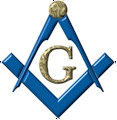The following was presented April 15, 2025, by Education Officer Tom Lewis.
The Three Lesser Lights
- Wade Sheeler, PSGW Grand Lodge of Iowa .
Emessay Notes, December 2024 .
When an Entered Apprentice is first brought to light, the first thing he discovers is the Three Great Lights of Masonry, illuminated by the Three Lesser Lights. The Lesser Lights are illuminated whenever the lodge is open, and the Three Great Lights are displayed and darkened when the Great Lights are displaced. The Lesser Lights are only discussed one time in the ritual, when the newly initiated brother is first brought to light as an Entered Apprentice ( . . . ).
What is uniform throughout Masonry is the triangular formation, what is different is the shape and size of the triangle. The number “three” is prevalent throughout Ancient Craft Masonry. It is the first of three great Sacred Numbers of the Ancient Mysteries, three was the numerical symbol of God ( . . . ).
The triangle, like the circle, is without a beginning or ending. One line or two lines, have ends. They start and finish. Like the square or the five or more-sided figure, the triangle has no loose ends. As God was always considered as first and without either a beginning or ending, the triangle itself became a symbol of Deity ( . . . ).
The origin of the Three Lesser Lights. In the earliest recorded accounts of the Elusian Mysteries of ancient Greece, we find three lights about the holy place, representing the Sun, the Moon, and Mercury. How and when the Worshipful Master was substituted for Mercy is lost to time.
The Worshipful Master rules and governs his lodge as truly as the Sun and Moon govern the day and night. There can be no lodge without a Worshipful Master, in essence he is the lodge itself. There are some things he can’t do that the brethren under him can do. But without him the brethren of the lodge can’t do anything, while with the brethren’s consent or assistance, he can do much.
One of the principle duties of the Worshipful Master is to give proper instruction and set the craft at work. The inclusion of light as a symbol of his authority is but a logical conclusion of the Masonic doctrine of the East as the source of Masonic light to the brethren.
The light in the East is dedicated to the Master of the lodge, the one in the west to the sun, and the one in the south to the moon ( . . . ). In pointing out the placement of the lesser lights to a new initiate, the Master should be careful to first call attention to the light in the West representing the Sun, the one in the South representing the Moon, and the one in the East representing the Master.
By the light that radiates from the Three Lesser Lights, the Entered Apprentice is led to see those objects which mean so much to a Mason, the Great Lights, the inestimable gift of God to man as the rule and guide for his faith and practice, those tools that are dedicated to the Craft and to the Master the Alpha and Omega of Freemasonry.
Light alone is not enough. Light must also be used. As the lodge as a whole is a symbol of the world, so should a Mason’s heart be to him a symbol of the lodge. In his heart, he should ever carry the teachings of the Great Light, ready with his spiritual compass to lay out his work; with his spiritual square ready to square his work and actions towards all mankind, especially a brother Mason.

